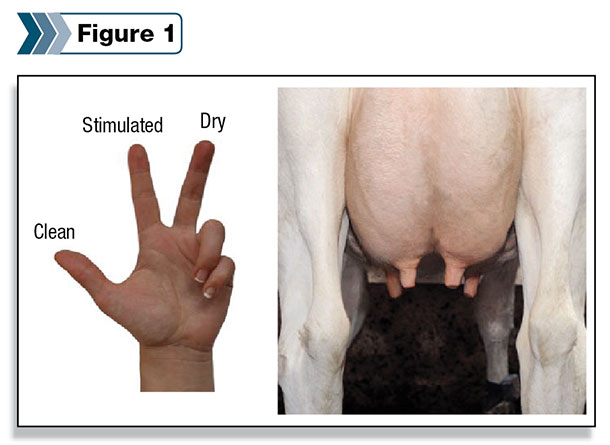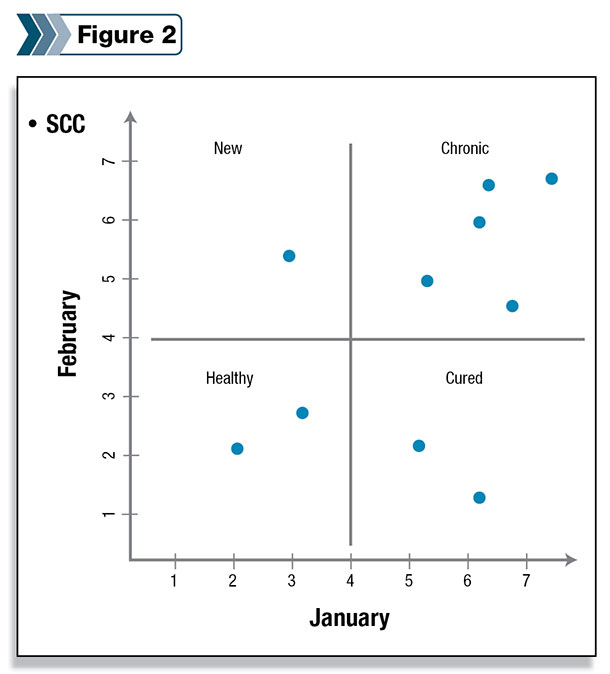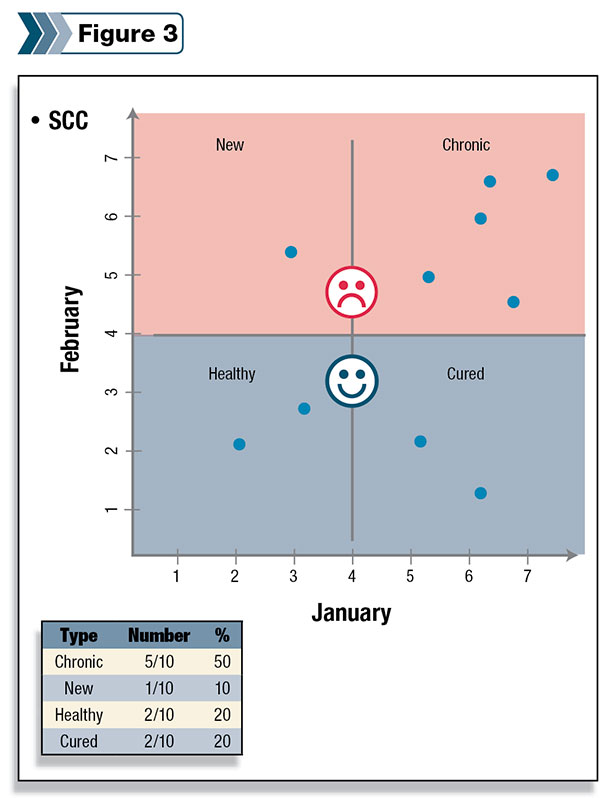Dairy producers are constantly looking for ways to increase profitability, especially in times of low milk prices. Milk is the main product of the majority of U.S. dairy herds, and its volume and quality is directly associated with the farm’s gross income.
Minimizing health problems is one of the key factors to profitability. High milk yield is the outcome of healthy and non-stressed cows.
Last July at the national American Dairy Science Association meeting in Orlando, Florida, Dr. Jason Lombard and his collaborators revealed pieces of the 2014 National Animal Health Monitoring System (NAHMS) survey.
Study data were collected from 1,261 dairy operations from the nation’s top 17 dairy states. The most prevalent health problem in dairy herds was mastitis, with 24.1 percent of the total cows affected by the disease. This number was 16.5 percent in 2007. A high number of cows with mastitis most likely means more antibiotic products are being used to treat those animals.
In 2015, the USDA and FDA released the United States National Residue Program quarterly report (April-June 2015) for antibiotic residues in meat, poultry and egg products. The three most prevalent antibiotic compounds found were ceftiofur, penicillin and sulfamethazine.
Carcasses of dairy cows were the ones with a higher number of positive samples (54 percent or 132 of 241 samples) when compared with beef and others. Needless to say, those results raised a red flag in the dairy industry, among consumers and in governmental agencies.
In the same year, the FDA released the Milk Drug Residues Sampling survey in raw milk. Researchers visited dairy herds that had at least one antibiotic-positive sample at the slaughterhouse (targeted herds) but also herds that have never had a positive case (non-targeted herds).
On the targeted herds, 1.15 percent of the raw milk samples (11 of 942) were positive for antibiotic residue, while non-targeted herds had 0.42 percent of the samples (four of 955) positive. Even though just a small percentage of the samples were positive, it was clear that targeted farms were more at risk (almost three times more) of having antibiotic residue in raw milk.
Shortly after that, the FDA proposed a final rule to the Veterinary Feed Directive (VFD) aiming to improve antibiotic utilization in dairy herds.
The VFD was released in October 2015 and will go into effect in December of this year. It changes the way veterinarians authorize the use of medicated feed additives considered medically important to humans. The VFD is based on two main points:
- Judicious use of medicated feed additives will be limited to treatment, prevention or control of disease. Therefore, growth promotion and feed efficiency indications will no longer be on the labels of these products.
- Use of these products will require a valid veterinary-client-patient relationship (VCPR), and the veterinarian must write a VFD enabling the producer to use these products.
An example of how the VFD may impact your farm is the utilization of medicated milk replacers. Producers must use these products only for the duration approved on the label and not for continuous use of feeding.
Dairy producers should talk to their veterinarian and establish a plan before December 2016. We know that one of the best ways to prevent the use of antibiotics in the herd is to reduce the number of mastitis cases.
Mastitis is the inflammation of the mammary gland and can be diagnosed by different methods. Clinical mastitis is usually diagnosed when farmers see altered milk (flakes) in the milking parlor when performing forestripping or after milking when looking at the milk filter of the milking equipment.
Subclinical mastitis can be diagnosed by sending a milk sample to the laboratory so the amount of somatic cells (white blood cells) in the milk can be counted (SCC; somatic cell count). The National Mastitis Council (NMC) suggests that milk samples with a result of 200,000 somatic cells per mL of milk (linear score = 4) or higher is indicative that the cow is trying to defend itself against a pathogen (usually bacteria) and therefore has mastitis.
The SCC contribution from all the cows in the herd can be easily accessed by the bulk tank SCC. According to the 2014 NAHMS survey, dairy farmers are improving their milk quality in the last years since bulk tank SCC dropped from 300,000 to 200,000 cells per mL from 1996 to 2014. It is important to remember that bulk tank SCC has been associated with antibiotic residue.
Studies conducted by the University of Wisconsin and others have shown that herds with high SCC are at increased risk for antibiotic residue violations. Wisconsin dairy herds with SCC greater than 700,000 cells per mL had seven times more chances of having antibiotic residue violations when compared with dairy herds with less than 251,000 cells per mL.
Researchers highlighted that most dairy farms do an excellent job of preventing antibiotic residues in milk. Lesson to be learned: Low SCC (meaning lower prevalence of mastitis) is a critical control point for antibiotic residues violation.
In order for mastitis to occur, the micro-organisms have to reach the interior of the mammary gland. How does that happen? Remember, bacteria don’t jump or run.
First, they need to colonize the skin of the teat. Infection usually occurs when the bacteria colonizing the teat is “flushed” or “pushed” into the mammary gland through the teat sphincter (orifice in the end of the teat).
This process usually occurs at the beginning or end of the milk procedure due to milk reflux caused by air entry in the system when liners are not well adjusted to the teat of the cow. This is why it is so important to have clean udders at the milking parlor; it makes the job of the milkers much easier to deliver a clean teat.
Dairy herds have different milking procedures. Independent from the milking procedure your farm adopts, you should make sure all cows are being milked under the three most important conditions: Cows need to be milked with clean, stimulated and dry teats (Figure 1).

Mastitis prevention is a team effort, and therefore extra work should be done so every member of the team gets the same message. For example, people have different impressions and opinions on what a clean and dry teat is. Improving communication in the milking parlor will make variation disappear or be reduced.
One management tool that would improve results is to check, by passing a swab or clean dry paper on the teat end just after preparing the cow and just before attaching the unit to the cow.
If your swab has residues of pre-dip or organic material (dirt), you could give to that teat (quarter) a score of 3. If your swab has no residues, you would give that teat a score of 0. You should not have more than 20 percent of the teats with score 3.
Make sure to evaluate 10 percent of the cows in a pen, or at least 15 cows, to get a representative sample. Show the results to your milkers and explain the difference between clean and dry to dirty and wet.
By doing that, you will be making sure that the end of the teat is not contaminated with bacteria and therefore will prevent new infections (mastitis).
What is the mastitis prevalence in your herd? Are you reaching your goals? By sending monthly individual milk samples from your cows to the lab for SCC screening, you can easily answer that question. Figures 2 and 3 show a representation of the SCC (linear score) of your cows (filled circles) this month (y axis) and last month (x axis).

You can see that one cow had a low SCC last month but this month had a high SCC, and therefore we will classify her as having a new infection. Chronic infections will be all the cows (five in this example) that on both months had a high SCC.

Healthy cows (two in this example) never had high SCC, and cured cows (two in this example) will be the ones that had lower SCC this month when compared with the SCC for the previous month.
The table in the figures shows you the percentage of your cows per quadrant. Most of the dairy management software can make the reports automatically for you. With these numbers in hand, it is time to check if you are achieving your goals.
It is pivotal for antibiotic residue avoidance and low SCC (low mastitis) that you consult with your veterinarian for a comprehensive and successful milk quality program. PD
Phil Cardoso is an assistant professor with the Department of Animal Sciences - University of Illinois. Email Phil Cardoso.
Take-home message:
- It is important to control SCC constantly, not only when problems or mastitis outbreaks happen.
- Milk clean, stimulated and dry teats.
- Reduce infections, their duration and the numbers of cull cows due to mastitis.
- Have goals:
- MAX: 12 percent new infections (SCC) / 30 days
- MAX: 2 percent clinical mastitis every month
- MIN: 50 percent cured infections (SCC) / 30 days
- MAX: 5 percent culled cows due to mastitis






